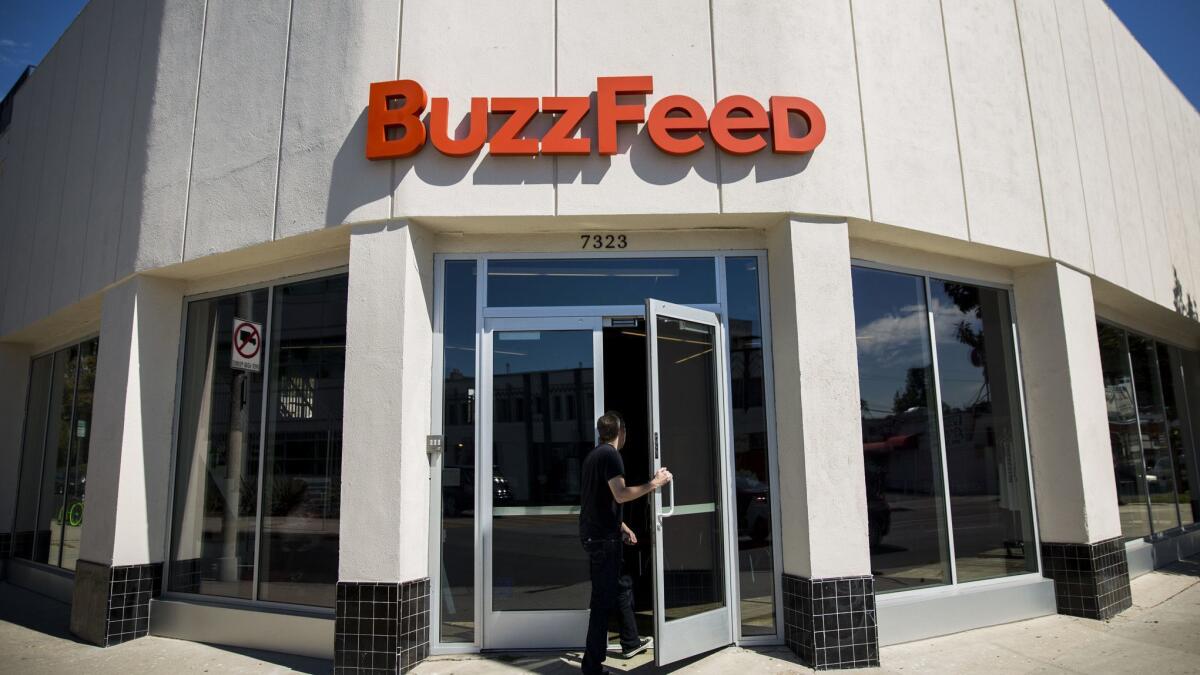BuzzFeed, Vice and other outlets slash jobs in a challenging market for digital media

When it debuted in 2006, BuzzFeed quickly became a social media sensation. Its listicles, quizzes and funny videos went viral and created a huge audience online. The New York-based start-up later hired hundreds of journalists to do serious journalism, creating a platform that many saw as the future of the industry.
But the digital media trailblazer confronted some harsh realities in the last week when as many as 250 workers, including roughly 75 employees in Los Angeles, lost their jobs.
Shedding 15% of its staff was a bruising moment for BuzzFeed and the latest sign of distress in the once-booming digital media sector, where many outlets have struggled to capture enough ads and digital subscriptions to cover rising expenses.
Some analysts and former employees say BuzzFeed was hurt by its large ambitions, staffing up too quickly and becoming overly reliant on growing its audience through publishing platforms like Facebook. But the problems also reflect deeper challenges that have squeezed many other digital media sites that pursued a similar business model, one based on building a large following on Facebook and YouTube and selling that viewership to advertisers, analysts said.
“They’re all built on the...principle that we can amass a great multiplying audience and we can sell those eyeballs to advertisers,” media analyst Ken Doctor said. The model is “broken at this point.”
Last year, digital media companies including Vox Media Inc., Refinery29 and Mic slashed payrolls. Vice Media last week confirmed it will eliminate about 250 jobs, or 10% of its workforce. Verizon Media Group, which includes properties like the HuffPost and TechCrunch, also recently announced it would cut 7% of its workforce. That affected more than 100 employees in offices in Sunnyvale and San Francisco, according to notices filed with the state’s labor department.
The underlying problem is that these companies are heavily reliant on distribution platforms they don’t control. Digital media companies typically generate ad revenue based on the size of their audiences, and consumers discover many of those videos and articles through sites such as Facebook and YouTube. As a result, they’ve had to follow the tech giants’ rules on how revenue is shared and adapt to any algorithm changes Facebook and Google introduced.
Many of these digital media sites have enjoyed substantial financial backing, but investors have grown impatient with losses.
BuzzFeed, for example, is owned by media giant NBCUniversal and other well-heeled investors. It has raised $497 million and has a valuation of $1.7 billion, according to research firm CB Insights. But pressure has been mounting on BuzzFeed to generate more revenue after missing its sales goal in 2017. Although the company had more than $300 million in revenue last year and claims an audience of more than 650 million people, BuzzFeed was still unprofitable, according to two people familiar with the company’s finances who were not authorized to comment.
“It’s a very expensive company to keep afloat,” said Eunice Shin, a partner at Prophet, a brand and marketing consultancy.
BuzzFeed Chief Executive Jonah Peretti said in a note to employees that “the restructuring we are undertaking will reduce our costs and improve our operating model so we can thrive and control our own destiny, without ever needing to raise funding again.”
The company made changes to its business, including merging its commerce and marketing team, cutting its newsroom staff and reducing its teams abroad.
Google and Facebook own and control many of the world’s most popular platforms, including YouTube, Facebook and Instagram. To get access to those audiences, publishers on those platforms need to share a large chunk of their digital ad revenue with Facebook and Google. Facebook, for example, takes about 45% of the ad revenue generated by commercials on videos distributed through its platform Facebook Watch.
“The devil’s bargain there is you get a bigger audience, but you are giving up a lot of revenue and you don’t control the experience,” said Paul Verna, a principal analyst at EMarketer.
The amount of money that publishers are earning in digital ads through Facebook and Google is disproportionate to the amount of traffic they receive from those sites, said Jason Kint, CEO of Digital Content Next, a trade group. In 2017, premium publishers received less than 5% of their digital revenue through Facebook or Google platforms, even though 30% of their search traffic was coming from Google, Kint said. Publishers “were not receiving the fair value,” he added.
Compounding matters, Facebook has changed its algorithm to highlight original content from users’ friends over videos or news stories from companies, which affected business models of publishers that rely on views.
“Facebook is known for changing the algorithms, which makes companies that use [Facebook] as their prime source of getting viewers more vulnerable than ever,” said Peter Cowen, a lecturer at the UCLA Anderson School of Management and managing director of investment banking firm Sutton Capital Partners.
Both Google and Facebook have said they are working to help publishers, offering funding and resources to help newsrooms improve their operations.
Another problem is that digital media outlets also rushed to capitalize on video, a growing digital ad category on Facebook and Google’s platforms. But companies realized that it was expensive to create video content, and pumping out viral videos did not help them build long-terms brands or intellectual property that they could capitalize on later.
“It’s like junk food,” Verna said. “It lasts while it lasts, but it’s not something that has any legacy value.”
BuzzFeed has tried to build a brand around its “Tasty” cooking videos and is selling associated cookware and accessories at Walmart, but analysts say the company could have built a larger library of branded content similar to Netflix.
BuzzFeed News’ reputation took a hit last month when Special Counsel Robert S. Mueller III’s office disputed a story that said his office had evidence that President Trump had instructed his former lawyer Michael D. Cohen to lie to Congress. BuzzFeed stood by its story, but no other media outlets have been able to verify its report. Former employees at BuzzFeed said they do not believe that the Mueller dispute contributed to the layoffs.
Other digital media companies such as Verizon Media Group struggled to position themselves as an alternative to Facebook and Google for digital ads. Verizon had purchased AOL for $4.4 billion and paid $4.5 billion for Yahoo’s internet properties in a bid to expand its content and ad offerings.
But there were challenges surrounding efforts to combine cellular data with the advertising side of its business. Verizon also struggled to generate enough ad revenue to justify the cost of its video productions, shutting down its streaming service go90 last summer. In December, Verizon wrote down the division that encompassed its AOL and Yahoo purchases by $4.6 billion after it did not meet revenue and earnings goals.
Verizon Media Group CEO Guru Gowrappan said in a memo to employees regarding the layoffs that he sees “focus as a key ingredient to success,” meaning “going deeper on fewer, key things that will have the greatest impact on our customers and business, and doing them exceptionally well.”
Verna says he believes the same logic could be applied to BuzzFeed, which he says has struggled to figure out what it is about — whether it be Tasty, clickbait headlines, memes or serious journalism. “They flailed at trying to be good at all of those things,” he said.
Other ways digital media companies can try to grow revenue is through digital subscriptions or membership models similar to public radio.
Doctor, the analyst, says he expects more consolidation will happen among digital media companies, allowing them to cut costs and grow. Last year the news site Mic, which raised $60 million, was sold to Bustle Digital Group, which creates content geared toward women, for about $5 million.
“Cost-cutting gets you the most immediate return to maintain profits,” Doctor said.
Peretti, BuzzFeed’s CEO, has said he would be open to mergers.
But for the hundreds of employees who lost their jobs in January, the layoffs were a sober dose of reality to a company that offered perks such as free lunches and was on a hiring spree not too long ago. In August, BuzzFeed hosted a recruitment event with an open bar during the Asian American Journalists Assn. conference in Houston. In recent months, however, former employees said the company began showing signs of financial strain, as some positions that were vacant were not filled.
The layoffs took a bitter turn when news leaked out that Peretti was considering allowing in dogs to cheer up the staff, but that the company would not pay for accrued time off for all the laid-off U.S. workers. BuzzFeed later reversed its position.
BuzzFeed “was viewed as this great hope for journalism,” said one former employee, who declined to be named. “The speed with which we went from being the gold standard to suddenly being this place of gloom and doom is really head spinning.”
Times staff writer Alexa Díaz contributed to this report.
Twitter: @thewendylee
More to Read
Inside the business of entertainment
The Wide Shot brings you news, analysis and insights on everything from streaming wars to production — and what it all means for the future.
You may occasionally receive promotional content from the Los Angeles Times.











